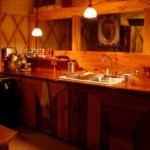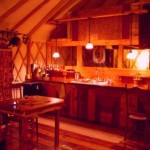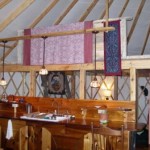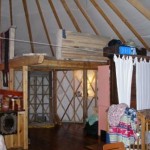Todd and Monica have a 30′ fabric yurt, but unfortunately they purchased it a couple of years ago from a company that advertises cheap yurts. There were so many problems with their yurt when it arrived (six months late) that it took them an additional six months to put it up. The good side, they said, is that they now know enough about yurts to build their own.
The most amazing thing about Todd and Monica’s yurt is the insulation. In addition to a layer of the usual Reflectix bubble wrap/foil insulation, Monica added a complete inside layer of real felt. The felt, imported from India, came in 7′ rolls. Monica hand stitched the wall sections, with cutouts for the windows, and had a friend machine-stitch 6 large pie-shaped wedges to go on top of the rafters.
The Reflectix layer, which is sandwiched between the felt and the outer covering of the yurt, functions as a
vapor barrier as well as providing additional insulation (and reflecting out the sun’s heat in the summer). Monica pointed out the importance of keeping the felt dry, as it can easily mold or rot if it gets wet.
Monica and Todd are gradually building in all the comforts of home as they
have time and can afford it. This is a great option with yurts–to start with a minimal investment and a simple lifestyle and gradually add the amenities. This is also a great approach for the do-it-yourselfer.
In this case, Monica and Todd started with a kitchen counter and are adding a loft (like Kim and Russell’s, see previous entry) in stages. They’ve installed all the electrical and plumbing themselves, learning as they went, and built a beautiful checkerboard dining table.. The yurt is warm and welcoming, and although the size is the same as Kim and Russel’s, and the floor plan similar, the feel of the yurt is
completely different.

Outside you’ll find an outhouse toilet, a
wood-fired hot tub, and a little (14′) Pacific
Yurt guest yurt nestled in the forest about a hundred feet from the main yurt. The guest yurt is used for visiting in-laws and will function as a bed and breakfast this coming summer.
It was hard to leave. The yurt was lovely and cozy, and the
company so compatible. But we eventually did, and I will close now with
a quote from a daughter of one of the visiting yurt couples:
“I like our yurt because there are no corners for the ‘afraids’ to hide
in.”
4 Responses to “Felted yurt insulation”
Sorry, the comment form is closed at this time.



I’m inspired by Monica and Todd’s insulation idea and am interested in learning who they ordered the felt from.
I’m planning to make insulation for my 20′ yurt out of Reflectix but this sounds far better for Montana winters!
Thanks for sharing and hope to hear from you.
Eva
I’m interested as well. We’re planning on putting up a 30 foot Colorado Yurt this summer, and would love to use real wool insulation…
any idea how to contact Todd and Monica regarding where they got the felt?
It seems to me that unfelted wool insulation would be a better option if there
is already a waterproof barrier on the outside. Good Shepherd out of Canada
sells wool insulation for conventional buildings.
I am in the midst of building a 30ft. I very interested in the access of the wool felt from India.
Thank you, Karen